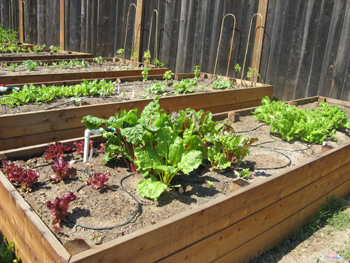
Since it’s been a while, I thought it was time for another update on the plant denizens of our raised garden beds which we planted back in July.
The first thing to note is that, to a first approximation, the automatic drip irrigation system we set up to water the beds works reasonably well. There are a few patches that don’t get quite enough water without some hand-watering every couple days, but the important thing is that the seedlings made it through our week-long trip to Wisconsin last month.
The second thing to note is that we’ve been having rather more hot spells this summer than is (was?) normal for our region. This means that some of the seeds I planted that are supposed to be sowed in mid- to late-summer may be feeling like they were planted at the beginning of the summer. I offer my sincere apologies to the confused seedlings that have resulted.
Still, at this stage of the game, it’s looking like most of what I planted is humming along reasonably well.
Exhibit A: the rainbow chard.
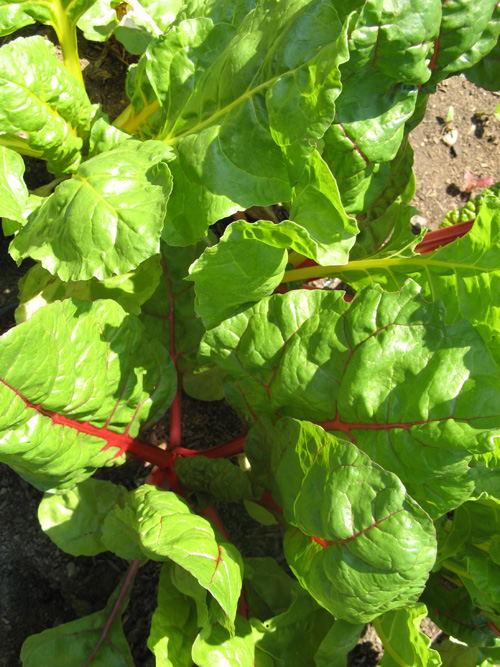
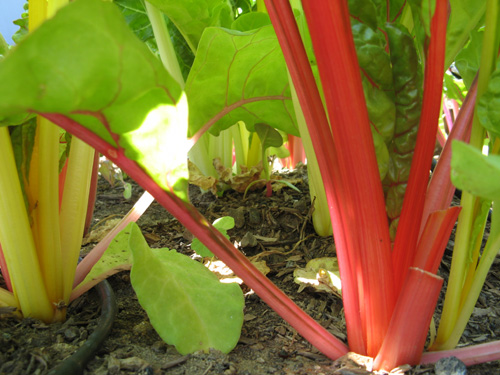
The chard is growing like gangbusters, and what’s pictured here is the chard after a major harvest a few days ago (to make a chard gratin with goat cheese). In another day or so, we’ll probably make lemon-chard soup. (The sprogs also want to try chard raw, just to see what it tastes like.)
If you have a good (and meatless) chard recipe, please share it in the comments!
Exhibit B: mustard greens.
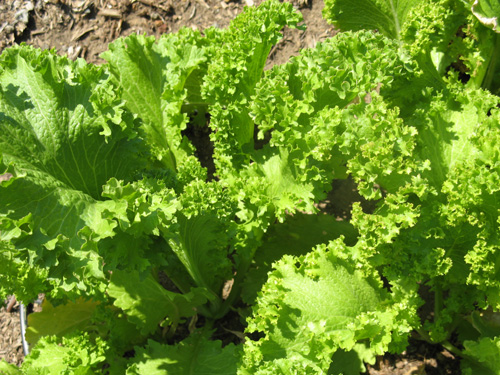
Our other quick-to-maturity leafy green. At least some of these mustard greens are going to end up in a curry.
Exhibit C: daikon radish.
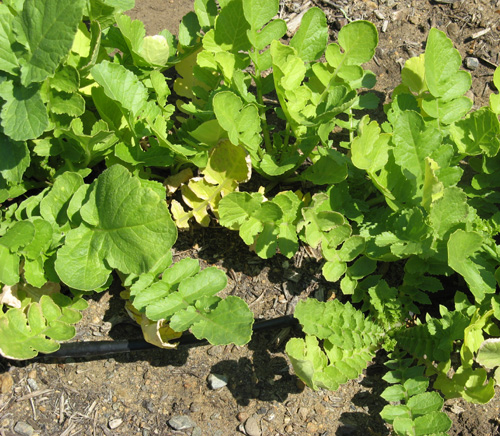
I’m pretty sure these daikons have more time before they’re officially ready to harvest, but their greens looks pretty healthy.
Exhibit D: lettuce.
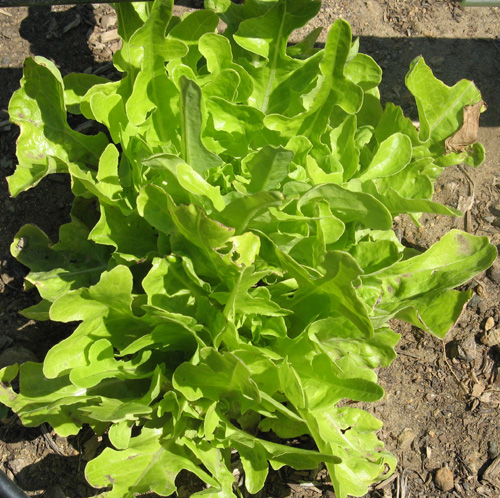
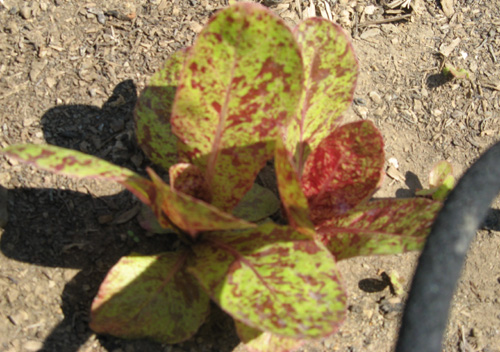
So far, to my surprise, none of the lettuces have bolted. The oakleaf and “freckles” romaine pictured above are getting almost big enough for me to start harvesting leaves. I’ve already harvested many salads’ worth of leaves from the “red sails” leaf lettuce (or maybe “redina”?) pictured in the foreground in the photo at the top of the post.
Exhibit E: turnips and beets.

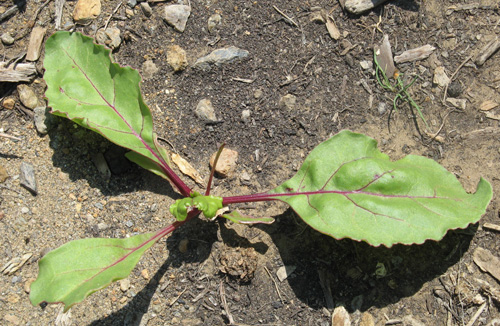
The turnip greens looks more developed at this point than the beet greens, but in the absence of a subterranean surveillance camera, I can’t be certain that the same is true about the roots.
While we’re eating chard, I can be patient with the root veggies.
Exhibit F: beans in bloom.
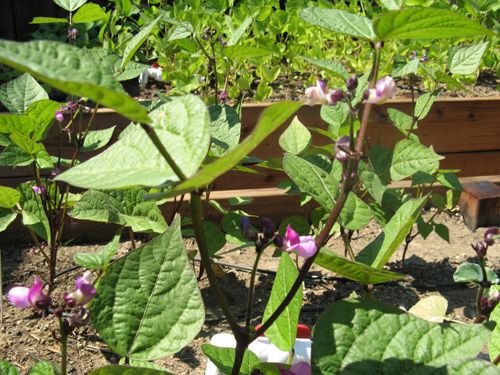
The purple bush beans have set out pretty purple flowers. (Still waiting for the green beans and the yellow wax beans to bloom.) The soy beans have set out white flowers. The scarlet runner beans have set out (wait for it) scarlet flowers.
Of course, we’re less than halfway to harvest for the carrots, and the onions and cabbages and parsnips and kohlrabi still have a ways to go.
Meanwhile, from elsewhere in the back yard:
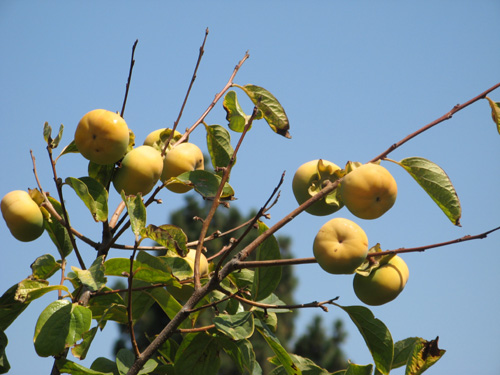
It looks like it’s going to be a good year for persimmons.

You is a cool mom creature.
A chard recipe (from Mark Bittman’s How to Cook Everything via my memory- we may have changed this over time!)
After washing your chard, de-stem it and cut the leaves into strips (a chiffonade.)
(If you like the stems, you can chop them up as well.)
Saute some garlic in olive oil, then add the stems (if you are using them) or the leaves and let them cook down.
After the leaves have cooked down, add some vegetable stock or white wine, pine nuts and currants, and a squeeze of lemon juice. We’ve added crushed red pepper from time to time.
This is a tasty side dish on its own, and make a really tasty sauce on top of ravioli.
Young leaves of raw chard can make a great salad (as can young kale). A sweet and sour salad dressing goes very well with both — something like this one: http://allrecipes.com/Recipe/Sweet-and-Sour-Dressing/Detail.aspx except I’d use cider vinegar.
Mmm, your chard looks yummy! I love it just sauteed with olive oil and garlic.
Why heads of lettuce and not leaf lettuce? I planted leaf lettuce in my container garden – I felt I got more lettuce for my space that way.
There’s several good recipes in the Moosewood Cookbooks, but generally we just throw chard in whatever stirfry of the day we’re fixing. None of the others are coming to mind off the top of my head right now.
I agree with chezjake – baby chard is delicious in salads!
Most hardy greens (chard, kale, mustard…) are yummy folded into black-eyed peas–especially with some garlic and a garnish of diced red onion or chow-chow (if you can get it). One of the Moosewoods has a recipe to that end.
Outstanding gardening.
Unfortunately I failed to inherit the green thumb. My sister could, quite literally, pound in discarded pine branches to create a fence to keep the bunnies out and more than half of the stakes spouted and, after the growing season was over and they had done their job keeping the cottontails out, they were successfully replanted elsewhere in the yard.
My pathetic attempts at gardening more closely resemble running a plant hospice. They come here to die. And we aren’t talking peaceful and pleasant deaths. A neighbor described it as ‘death by slow torture’. After my loving attempts at cultivation and nurturing, all to-the-letter and correct, the plants just seem to slowly give up.
Often the native insects, worms and caterpillars, clearly offended and acting out of a sense of justice and right, swarm in and perform vegetative euthanasia. Bringing a measure of peace and mercy to the long suffering inhabitants of my garden.
Anyway, now that I’m feeling down after contemplating my failure as a gardener, I think you have done a fine job. May you have all the luck in the world with this season and the next.
Oh! I bet you could substitute chard for the kale in this 101 Cookbooks recipe: http://www.101cookbooks.com/archives/lemony-chickpea-stirfry-recipe.html
I’m so jealous of your big backyard and your raised beds. We scored a plot Don’t all those happy green leaves make all the work worth it?
http://teach77.wordpress.com/ for recipes. She often posts vegetarian. She’s also got a blogroll full of yummy other cooks.
For those who prefer not to have to actual pieces of vegetables in their food (eg the males in my household), I make a vegetarian pasta sauce with steamed chard, garlic, goat cheese, ground almonds or pine nuts, and a bit of parmesan, all mixed up with a hand blender. (No, I have no idea of the exact quantities – recipes are only general guidelines anyway.)
Alas, the growing season here is almost over – at least I have a nice crop of basil to dry or freeze, as long as I remember to harvest it before the first frost, due within the next few weeks. My habanero pepper plants have been quite a disappointment though – 2 nice leafy plants, but they only managed 1 pepper between them.
I moved into a new place (doing an internship), and we inherited a garden from the previous interns. They also planted lots of chard! I bet it would also work well with chunks of tofu.
I bet it would also work well with chunks of tofu.
My favorite things to do with it:
– swiss chard mashed potatoes — I dice up the leaves and fold them into my mashed potatoes (I make mashed potatoes with the skin still on for extra nutrients, and I mash the potatoes in some of the boiling water with some butter). You can sautee the leaves first or just put them in raw. I suggest adding them in raw if the potatoes are still really hot, as that heat will wilt the leaves a bit. for extra garnish, I add cheese, but it’s not necessary.
– swiss chard and yams. I make this with tilapia, but the meat is not necessary. I parboil the yams and then dice them up. I dice up the stems and leaves of the chard separately. bake or sautee the stems and the yam chunks (seasoning with some kind of vinegar, pepper, and whatever else you like — we use chives and basil from our garden). then, near the end, add in the diced leaves and cook until they wilt. another really yummy dish
I love adding chard and other greens to soups. White bean soup with greens = yummy. I have no recipe for this, I typically just soak some beans overnight, cook some mire poix (onions, carrots, celery) in a little oil, then throw in the beans and whatever else in the fridge I need to get rid of, then add broth or water and simmer for an hour. Put the greens in a few minutes before serving to wilt them down.
You could make the same soup and puree it with a stick blender, then serve the creamy style version drizzled with olive oil and/or sprinkled with grated parmesan.